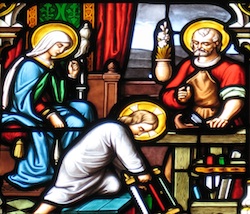More Precious than Gold: The Relics of the Basilica of the Sacred Heart
by Josh Noem
Why are the bones of a little girl from second-century Rome resting in a church in northern Indiana?
The remains of St. Severa, which are contained in lead boxes below this wax model of her body, are the focal point of the reliquary chapel in Notre Dame’s campus church, the Basilica of the Sacred Heart. A side chapel behind the main altar holds display cases containing more than 1,600 relics from nearly 800 different saints. Among these relics are fragments of St. Joseph’s robe and pieces of Mary’s hair, as well as chips from the column where St. Paul was beheaded and the cross upon which St. Peter hung upside-down.



The word “relic” comes from the Latin word for “remains” and refers to an object connected with a saint, such as a part of their body or clothing or an item that they used. Relics might be connected with saints or with holy men and women in the process of becoming saints.
There are three classes of relics: first-degree relics are parts of the saint’s body; second-degree relics are parts of clothing or an item used by the saint during life; and third-degree relics are composed of something that was touched directly to a first-degree relic.
Most relics in the Basilica are very tiny pieces of cloth or bone. Many in the reliquary chapel are inside a locket-type medallion, covered with glass, about the size of a quarter.
The Church teaches that only the Trinitarian God is worshipped and adored. We honor and venerate the saints, and we respect their relics as an extension of their existence. All Christians recognize Jesus as the source of divine grace, so Catholics do not look to relics as having any special powers in and of themselves.
An office in the Vatican, the Congregation for the Causes of Saints, verifies and preserves relics. By Church law, relics may not be sold or traded and can only be transferred with permission from this office.
“It is not merely by the title of example that we cherish the memory of those in heaven; we seek, rather, that by this devotion to the exercise of fraternal charity the union of the whole Church in the Spirit may be strengthened. Exactly as Christian communion among our fellow pilgrims brings us closer to Christ, so our communion with the saints joins us to Christ, from whom as from its fountain and head issues all grace, and the life of the People of God itself.”
CCC #957
Saints are a gift to us from God. They are examples to us of how to embody virtue in large and small moments of life; they are also our constant companions in prayer. FaithND offers details of the lives of saints because they remind us of our own calling to become holy by imitating Christ in our own time and place. This is the same reasoning that inspired Notre Dame’s founder, Father Edward Sorin, C.S.C., to collect relics of saints for veneration in the Basilica. “The relics of the saints are more precious than silver and gold,” he once said.
From the beginning, the church on campus was intended to have a special place to house the honored remains of the saints. The reliquary chapel was consecrated along with other side chapels and the Lady Chapel in the Basilica in 1888. Most of the relics were collected by Father Sorin, or offered as gifts by visiting bishops. Father Sorin made frequent trips to Rome, and may have acquired some there as well.
Relics remind us that men and women who lived lives of holiness in all times and places were real people with flesh and blood—that salvation history unfolded concretely in a tangible place and a specific time. Included in the reliquary, for example, are relics from each of the 12 apostles, a piece of the manger that held the infant Jesus in Bethlehem, and a fragment from the table where Jesus gathered with the disciples for the Last Supper. The chapel also holds a splinter from the True Cross that is used in Good Friday liturgies.





These relics remind us that we share with saints the same call to holiness and the same eternal destiny of union with God in heaven, and they tell us that this calling and this destiny is within our reach if we seek to conform our lives to Christ as they did.
Anyone can visit the reliquary chapel when the Basilica is open and not being used for liturgy—it is located behind the main altar on the right side of the church next to the Lady Chapel in the rear. The reliquary chapel contains a directory on a stand that lists the names of every saint with a relic on display, along with a map of where to find it.
Please Note: The Basilica’s reliquary chapel is currently under renovation. Upon completion, we will include an updated virtual tour to reflect this newly defined holy space.

